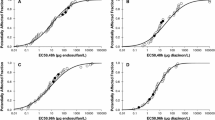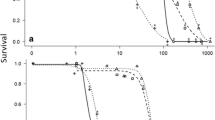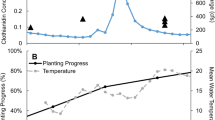Abstract
The toxicity of the pyrethroid insecticide λ-cyhalothrin to freshwater invertebrates has been investigated using data from short-term laboratory toxicity tests and in situ bioassays and population-level effects in field microcosms. In laboratory tests, patterns of toxicity were consistent with previous data on pyrethroids. The midge Chaoborus obscuripes was most sensitive (48- and 96-h EC50 = 2.8 ng/L). Other insect larvae (Hemiptera, Ephemeroptera) and macrocrustacea (Amphipoda, Isopoda) were also relatively sensitive, with 48- and 96-h EC50 values between 10 and 100 ng/L. Generally, microcrustacea (Cladocera, Copepoda) and larvae of certain insect groups (Odonata and Chironomidae) were less sensitive, with 48-h EC50 values higher than 100 ng/L. Mollusca and Plathelminthes were insensitive and were unaffected at concentrations at and above the water solubility (5 μg/L). Generally, the EC50 values based on initial population responses in field enclosures were similar to values derived from laboratory tests with the same taxa. Also, the corresponding fifth and tenth percentile hazard concentrations (HC5 and HC10) were similar (laboratory HC5 = 2.7 ng/L and field HC5 = 4.1 ng/L; laboratory and field HC10 = 5.1 ng/L), at least when based on the same sensitive taxonomic groups (insects and crustaceans) and when a similar concentration range was taken into account. In the three field enclosure experiments and at a treatment level of 10 ng/L, consistent effects were observed for only one population (Chaoborus obscuripes), with recovery taking place within 3 to 6 weeks. The laboratory HC5 (2.7 ng/L) and HC10 (5.1 ng/L) based on acute EC50 values of all aquatic arthropod taxa were both lower than this 10 ng/L, a concentration that might represent the “regulatory acceptable concentration.” The HC5 and HC10 values in this study in The Netherlands (based on static laboratory tests with freshwater arthropods) were very similar to those derived from a previous study in the United Kingdom (1.4 and 3.3 ng/L). This suggests that for pesticides like λ-cyhalothrin, HC5 values based on static laboratory tests may provide a conservative estimate of the potential for community-level effects under field conditions. While these HC5 values are conservative for initial effects, they do not provide information on recovery potential, which may be important for regulatory decision-making.
Similar content being viewed by others
Author information
Authors and Affiliations
Rights and permissions
About this article
Cite this article
Schroer, A., Belgers, J., Brock, C. et al. Comparison of Laboratory Single Species and Field Population-Level Effects of the Pyrethroid Insecticide λ-Cyhalothrin on Freshwater Invertebrates. Arch Environ Contam Toxicol 46, 324–335 (2004). https://doi.org/10.1007/s00244-003-2315-3
Issue Date:
DOI: https://doi.org/10.1007/s00244-003-2315-3




